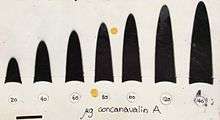Affinity electrophoresis

Affinity electrophoresis is a general name for many analytical methods used in biochemistry and biotechnology. Both qualitative and quantitative information may be obtained through affinity electrophoresis. The methods include the so-called mobility shift electrophoresis, charge shift electrophoresis and affinity capillary electrophoresis. The methods are based on changes in the electrophoretic pattern of molecules (mainly macromolecules) through biospecific interaction or complex formation. The interaction or binding of a molecule, charged or uncharged, will normally change the electrophoretic properties of a molecule. Membrane proteins may be identified by a shift in mobility induced by a charged detergent. Nucleic acids or nucleic acid fragments may be characterized by their affinity to other molecules. The methods have been used for estimation of binding constants, as for instance in lectin affinity electrophoresis or characterization of molecules with specific features like glycan content or ligand binding. For enzymes and other ligand-binding proteins, onedimensional electrophoresis similar to counter electrophoresis or to "rocket immunoelectrophoresis", affinity electrophoresis may be used as an alternative quantification of the protein. Some of the methods are similar to affinity chromatography by use of immobilized ligands.
Types and Methods
Currently, there is on going research in developing new ways of utilizing the knowledge already associated with affinity electrophoresis to improve it's functionality and speed, as well as attempts to improve already established methods and tailor them towards performing specific tasks.
Agarose gel electrophoresis

A type of electrophoretic mobility shift assay (AMSA), agarose gel electrophoresis is used to separate protein bound amino acid complexes from free amino acids. Using a low voltage (~10 V/cm) to minimize the risk for heat damage, electricity is run across an agarose gel.
Rapid agarose gel electrophoresis
This technique utilizes a high voltage (≥ 20 V/cm) with a 0.5× Tris-borate buffer run across an agarose gel.[1] This method differs from the traditional agarose gel electrophoresis by utilizing a higher voltage to facilitate a shorter run time as well as yield a higher band resolution. Other factors included in developing the technique of rapid agarose gel electrophoresis are gel thickness, and the percentage of agarose within the gel.
Boronate affinity electrophoresis
Boronate affinity electrophoresis utilizes boronic acid infused acrylimide gels to purify NAD-RNA. This purification allows for researchers to easily measure the kinetic activity of NAD-RNA decapping enzymes.[2]
Affinity capillary electrophoresis
Affinity capillary electrophoresis utilizes a formulary approach in accordance with the theory of electromigration.[3] This method utilizes the inter-molecular interactions found in a free solution. "Affintiy probes" consisting of fluorophore-labeled molecules that will bind to target molecules are mixed the sample being tested. This mixture and it's subsequent complexes are then separated through capillary electrophoresis. The principle behind this type of electrophoresis is the mobility of the target molecules being altered by inter-molecular interactions[4]
Affinity-Trap Polyacrylamide Gel Electrophoresis
Affinity-Trap Polyacrylamide Gel Electrophoresis (PAGE) has become one of the most popular methods of protein separation. This is not only due to its separation qualities, but also because it can be used in conjunction with a variety of other analytic methods, such as mass spectrometry, and western blotting.[4] This method utilizes a two step approach. First, a protein sample is run through a polyacrylamide gel using electrophoresis. Then, the sample is transferred to a different polyacrylamide gel (the affinity-trap gel) where affinity probes are immobilized. The proteins that do not have affinity for the affinity probes pass through the affinity-trap gel, and proteins with affinity for the probes will be "trapped" by the immobile affinity probes. These trapped proteins are then visualized and identified using mass spectrometry after in-gel digestion.[4]
Phosphate Affinity Electrophoresis
Phosphate Affinity Electrophoresis utilizes an affinity probe which consists of a molecule that binds specifically to divalent phosphate ions in neutral aqueous solution, known as a "Phos-Tag". This methods also utilizes a separation gel made of an acrylamide-pendent Phos-Tag monomer that is copolymerized. Phosphorylated proteins migrate slowly in the gel compared to non-phosphorylated proteins. This technique gives the researcher the ability to observe the differences in the phosphorylation states of any given protein.[4]
See also
References
- ↑ "http://resolver.ebscohost.com.webdb.plattsburgh.edu:2048/openurl?sid=EBSCO:edselp&genre=article&issn=00032697&ISBN=&volume=511&issue=&date=20161015&spage=36&pages=36-41&title=Analytical+Biochemistry&atitle=Rapid+agarose+gel+electrophoretic+mobility+shift+assay+for+quantitating+protein:+RNA+interactions&aulast=Ream,+Jennifer+A.&id=DOI:10.1016/j.ab.2016.07.027&site=ftf-live". doi:10.1016/j.ab.2016.07.027&site=ftf-live. External link in
|title=(help) - ↑ "Boronate affinity electrophoresis for the purification and analysis of cofactor-modified RNA". Institute of Pharmacy and Molecular Biotechnology, Heidelberg University, 69120 Heidelberg, Germany.
- ↑ "Affinity capillary electrophoresis: the theory of electromigration". Analytical and Bioanalytical Chemistry.
- 1 2 3 4 Kinoshita, Eiji; Kinoshita-Kikuta, Emiko; Koike, Tohru (2015-03-18). "The Cutting Edge of Affinity Electrophoresis Technology". Proteomes. 3 (1): 42–55. doi:10.3390/proteomes3010042.